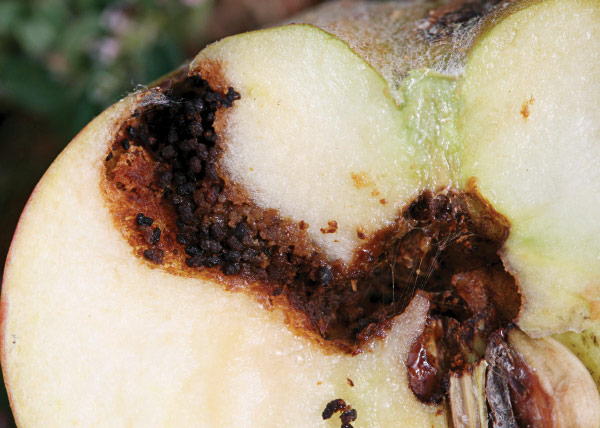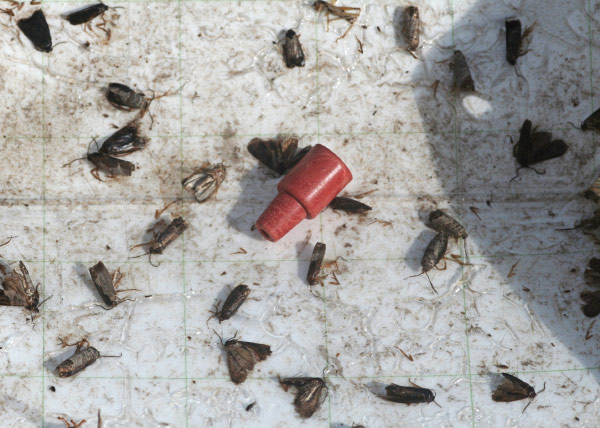In Favor of More Biologically Based Options
 |
|
Damage to apple by tunneling codling moth larva. Photo by Whitney Cranshaw, Colorado State University, Bugwood.org. |
Alternatives to conventional pesticides protect crops with reduced impacts on health and environment
Contacts
- Brian Baker, bpb33@cornell.edu, 541-228-0876
- Thomas Green, ipmworks@ipminstitute.org, 608-232-1410
- Ali Loker, aloker2@huskers.unl.edu, 608-332-1592
- Will Fulwider, wfulwider@ipminstitute.org, 608-232-1410
In a new article published in the international journal Biological Control, three experts call for increased investment in biologically based approaches to controlling pests in agriculture, citing underutilization.
For instance, despite their many benefits, biopesticides represented less than 4.5 percent of the overall $75 billion in global pesticide sales for 2017.
Meeting Consumer Expectations
Biological options are well aligned with consumer, food company, and farmer goals. Advantages over conventional pesticides can include fewer residues, less persistence in the environment, and ability for farmers and workers to get into fields for harvest and other operations immediately after application.
According to Dr. Brian Baker, article co-author and affiliate faculty member at Oregon State University, “Consumers increasingly view any pesticide residues on food products as unacceptable, even when below levels considered safe by regulators.”
Continued Baker, “This sentiment is reflected in sales of organic products, which exceeded $50 billion in the U.S. alone last year, with organic produce representing more than 15 percent of all produce sold in the U.S.”
“Consumers increasingly view any pesticide residues on food products as unacceptable, even when below levels considered safe by regulators.”
– Co-author Brian Baker, Oregon State University affiliate faculty member
Obstacles to Adoption
Additional investment is needed to overcome obstacles, including lack of biocontrol options for many key pests and insufficient awareness and training on effective use of existing, proven biological options.
The authors argue that both public-policy and private-sector strategies must be improved to overcome these barriers and increase incentives for research, education, and adoption—including factoring the full cost of conventional pesticide use into decision-making by government agencies, food companies, and farmers.
Limitations of Conventional Pesticides
Pesticides are invaluable tools for reducing pest-related crop losses in conventional and organic agriculture. In many cases, however, the costs of using pesticides go well beyond the purchase price paid by farmers. These costs include unintended impacts on the health of humans and beneficial organisms, environmental contamination, and development of resistance, whereby a pesticide ceases to be effective due to overuse.
For example, more than 40 weed species are now resistant to glyphosate, the active ingredient in Roundup. Resistance is of particular concern to organic growers, who have a limited number of allowable pesticide options. Losing any of those options to pesticide resistance is likely to have costly consequences for organic farmers, food companies, and consumers.
 |
|
Adult codling moths caught in a pheromone trap. Photo by Whitney Cranshaw, Colorado State University, Bugwood.org. |
Biocontrol Examples
Biologicals include natural enemies of pests, such as parasites and predators that feed on pests, and biopesticides—pesticides made with living organisms found in nature, or with the products of living organisms.
“Biologically based strategies include pheromones designed to prevent pests from finding mates,” says co-author Dr. Thomas Green, director of the Sustainable Food Group, a project of the IPM Institute of North America.
“Pheromone mating disruption has been a very successful strategy in a number of crops, including apples to control codling moth,” continued Green. “Release of sterile codling moths is another biocontrol success, supported financially by tax and apple grower dollars in British Columbia, creating a sustainable program that has reduced reliance on conventional pesticides.”
“Biological approaches to pest management and plant health can meet all of today’s consumers requirements for transparency and sustainability while also improving growers’ bottom line.”
– Pam Marrone, founder & CEO, Marrone Bio Innovations
Collaboration Is Key
The authors, members of a national organic and IPM working group, contend that greater collaboration between practitioners and researchers who work with organic agriculture and integrated pest management (IPM) can advance biological control as part of the solution to address the many challenges facing agriculture today, including low crop prices, climate change, and increasing market demand for low-impact production practices.
The article includes a review of the history and current state of organic and IPM in relation to adoption of biological control.
“This is an excellent, comprehensive paper calling out the need for more biologically based solutions in agriculture production,” said Pam Marrone, founder and CEO of biopesticide producer Marrone Bio Innovations.
According to Marrone, “There is a growing movement towards regenerative ag systems. Biological approaches to pest management and plant health can meet all of today’s consumers requirements for transparency and sustainability while also improving growers’ bottom line.”
To view the article, Biological Control and Integrated Pest Management in Organic and Conventional Systems, visit www.sciencedirect.com/journal/biological-control/vol/140/suppl/C.
This work is supported by the USDA National Institute of Food and Agriculture, North Central IPM Center projects AG 2012-51120-20252 and AG 2014-70006-22486.
The Northeastern IPM Center promotes integrated pest management for reducing risks to human health and the environment. If republishing our news, please acknowledge the source (“From Northeast IPM Insights”) along with a link to our website.
